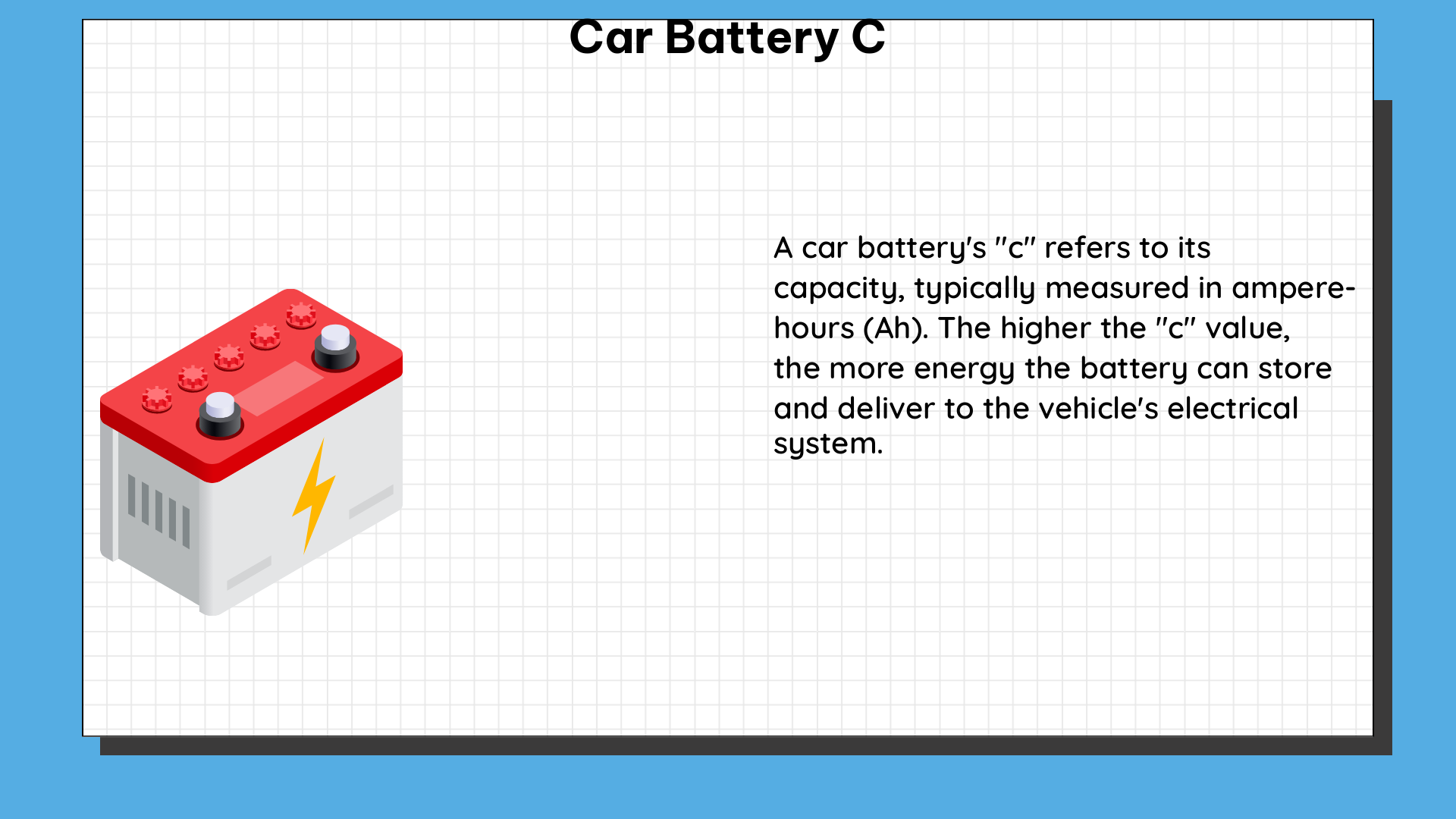The car battery C is a crucial component of any vehicle, responsible for providing the necessary power to start the engine, power the electrical systems, and maintain the overall performance of the car. Understanding the technical specifications and proper maintenance of a car battery C is essential for ensuring optimal performance and longevity.
Capacity: The Lifeblood of Your Car Battery
The capacity of a car battery C is a critical parameter that determines how long it can supply power to the vehicle’s electrical systems. This is typically measured in ampere-hours (Ah), which indicates the amount of current the battery can deliver for a specific period. For instance, a 600 CCA battery with a capacity of 420 Ah can supply 420 amperes for one hour or 210 amperes for two hours.
When selecting a car battery C, it’s essential to consider the specific power requirements of your vehicle. Factors such as the engine size, electrical accessories, and driving conditions can all impact the battery’s capacity needs. As a general rule, a larger capacity battery (e.g., 80 Ah or higher) is recommended for vehicles with high power demands, such as those with powerful engines, extensive electrical systems, or frequent use of energy-intensive features like air conditioning.
Voltage: The Heartbeat of Your Car’s Electrical System

The voltage of a car battery C is another crucial factor that determines its ability to supply power. The standard voltage for a car battery is 12 volts, although some batteries may have higher or lower voltages. The voltage of a battery can affect its performance, and a low voltage can cause starting problems or even damage the battery.
To ensure optimal performance, it’s essential to maintain the battery’s voltage within the recommended range. This can be achieved through regular testing and monitoring, as well as proper charging and maintenance practices. A voltmeter or multimeter can be used to measure the battery’s voltage, which should typically fall between 12.4 and 12.8 volts when the engine is running.
Cold Cranking Amps (CCA): Powering Through the Chill
Cold cranking amps (CCA) is a measure of a car battery C’s ability to deliver power at low temperatures. This parameter is typically measured in amperes and indicates the amount of current the battery can deliver for 30 seconds at 0°F (-18°C) while maintaining at least 7.2 volts.
A higher CCA rating means that the battery can deliver more power at low temperatures, which is essential for starting the engine in cold weather. This is particularly important in regions with harsh winters, where the battery’s performance can be significantly impacted by the cold.
When selecting a car battery C, it’s crucial to choose one with a CCA rating that matches the specific requirements of your vehicle and the climate in which you operate. As a general guideline, a battery with a CCA rating of at least 600 is recommended for most passenger vehicles, while larger or more demanding vehicles may require a higher CCA rating.
Maintenance: Keeping Your Car Battery C in Top Shape
Proper maintenance is essential for ensuring the longevity and optimal performance of your car battery C. Here are some key maintenance tasks to consider:
-
Water Level Checking: Regularly check the water level in the battery, especially in hot weather, as evaporation can cause the water level to drop. Top up the battery with distilled water as needed, being careful not to overfill.
-
Terminal Cleaning: Clean the battery terminals to prevent corrosion, which can affect the battery’s performance. Use a wire brush or baking soda and water solution to remove any buildup on the terminals.
-
Battery Testing: Test the battery regularly to ensure it is in good condition. This can be done using a voltmeter or a dedicated battery tester, which can provide valuable information about the battery’s state of charge, cranking power, and overall health.
-
Replacement: If the battery is no longer able to hold a charge or is not performing as expected, it’s time to replace it. Be sure to choose a replacement battery that meets or exceeds the specifications of the original battery.
By following these maintenance practices, you can help extend the lifespan of your car battery C and ensure that it continues to provide reliable power to your vehicle.
Conclusion
The car battery C is a critical component of any vehicle, and understanding its technical specifications and proper maintenance is essential for ensuring optimal performance and longevity. By focusing on factors such as capacity, voltage, and cold cranking amps, as well as implementing regular maintenance practices, you can keep your car battery C in top shape and enjoy a reliable and efficient driving experience.
References:
- Lithium-ion battery data and where to find it – ScienceDirect.com
- Rules for the calculation of the Carbon Footprint of Electric Vehicle – European Union
- Conversion to determine Ah of car battery? – Reddit
- Correlation between capacity loss and measurable parameters of lithium-ion batteries – ScienceDirect.com

The lambdageeks.com Core SME Team is a group of experienced subject matter experts from diverse scientific and technical fields including Physics, Chemistry, Technology,Electronics & Electrical Engineering, Automotive, Mechanical Engineering. Our team collaborates to create high-quality, well-researched articles on a wide range of science and technology topics for the lambdageeks.com website.
All Our Senior SME are having more than 7 Years of experience in the respective fields . They are either Working Industry Professionals or assocaited With different Universities. Refer Our Authors Page to get to know About our Core SMEs.